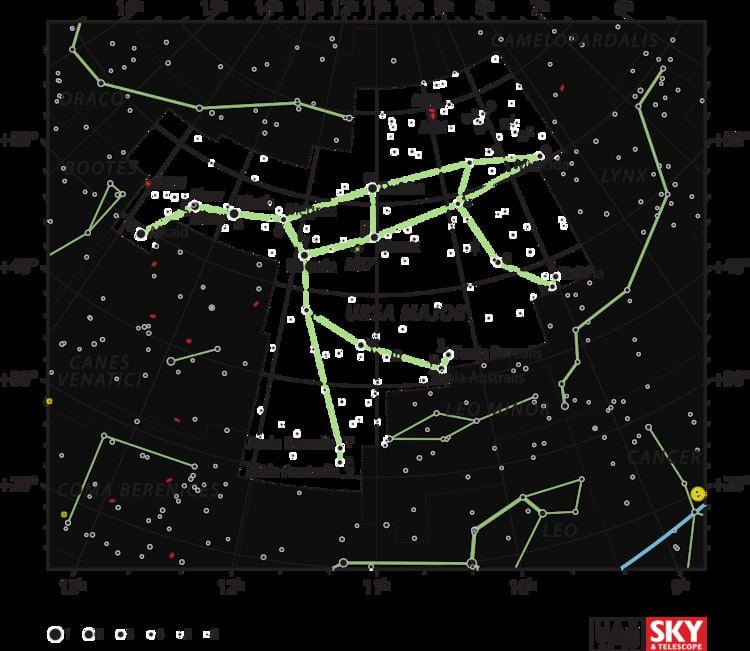 | ||
Iota Ursae Majoris (ι Ursae Majoris, abbreviated Iota UMa, ι UMa), also named Talitha, is a star system in the northern circumpolar constellation of Ursa Major. It has an apparent visual magnitude of 3.14, making it visible to the naked eye and placing it among the brighter members of this constellation. Based upon parallax measurements, it is located at a distance of 47.3 light-years (14.5 parsecs) from the Sun.
Contents
Nomenclature
ι Ursae Majoris (Latinised to Iota Ursae Majoris) is the star's Bayer designation.
The star bore the traditional names Talitha, Talitha Borealis and Alphikra Borealis. Talitha, which was shared with Kappa Ursae Majoris) comes from the Arabic phrase Al Fiḳrah al Thalitha "the third spring, or leap, of the ghazal". The term Borealis meaning "the north side" in Latin. In 2016, the International Astronomical Union organized a Working Group on Star Names (WGSN) to catalog and standardize proper names for stars. The WGSN's first bulletin of July 2016 included a table of the first two batches of names approved by the WGSN; which included Talitha for this star.
In Chinese, 三台 (Sān Tái), meaning Three Steps, refers to an asterism consisting of ι Ursae Majoris, Kappa Ursae Majoris, Lambda Ursae Majoris, Mu Ursae Majoris, Nu Ursae Majoris and Xi Ursae Majoris. Consequently, ι Ursae Majoris itself is known as 三台一 (Sān Tái yī, English: the First Star of Three Steps) and 上台一 (Shàng Tái yī, English: Star of First Upper Step).
The star was also dubbed Dnoces ('Second,' backwards) after Edward H. White II, an Apollo 1 astronaut. The name was invented by his fellow astronaut Gus Grissom as a practical joke.
Stellar system
The Iota Ursae Majoris system is composed of two binary stars. The brightest component is a white A-type subgiant. It is a spectroscopic binary whose components have an orbital period of 4028 days. The companion binary is composed of the 9th magnitude and 10th magnitude stars. These two stars orbit around each other with a period of 39.7 years, and are separated by roughly 0.7 arcseconds, or at least 10 AU. This pair may be the source of the X-ray emission detected from this system.
The two binary systems orbit around each other once every 818 years. The apparent separation between the two binaries is rapidly decreasing as they follow their orbits. In 1841 when the B component was first discovered, they had a separation of 10.7 arcseconds, or at least 156 AU. By 1971 their separation had decreased to 4.5 arcseconds, or at least 66 AU. This system appears to be dynamically unstable with a high likelihood and may become disrupted on a time scale on the order of 105 years.
